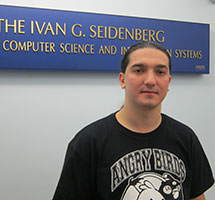 The name of Marius Agica, a senior majoring in both computer science and economics, appeared in The New York Times’ bridge column on September 7. Marius, a native of Romania, plays bridge competitively for his home country. Over the summer, he and his partner, Radu Nistor, placed third in both the Teams and Pairs events at the World Youth Congress held in Croatia.
The name of Marius Agica, a senior majoring in both computer science and economics, appeared in The New York Times’ bridge column on September 7. Marius, a native of Romania, plays bridge competitively for his home country. Over the summer, he and his partner, Radu Nistor, placed third in both the Teams and Pairs events at the World Youth Congress held in Croatia.
Marius Agica (BS/CS, BS/Economics ’11): an online interview
by Louise Kleinbaum
As a social bridge player who frequently reads The New York Times bridge column, I was surprised to learn that a Seidenberg student – Marius Agica – was a competitive bridge player. Curious to find out how he got into the game and what he liked about it, I decided to ask him a few questions:
| Q: | What motivated you to take up bridge and when did you start to play competitively? |
| A: | I have been exposed to the game ever since I was a child. My parents were serious bridge players and every summer we went to the largest bridge tournament in Romania where I watched my father play for 10 days straight. My brother, who is seven years older, started playing and, not wanting to be left out, I decided to learn to play too.
I started playing competitively when I was 12 years old but not really seriously until I made the Romanian Junior Team when I was around 16-17. |
| Q: | How many master points do you have? |
| A: | I don’t really take all that much stock in master points because “I think they are a very bad way to measure one’s bridge achievements.” But to answer your question, I have over 150 World Bridge Federation master points which qualifies me to be a World Master. |
| Q: | One of the nice things about playing bridge competitively is that you get to travel and meet people from all over. Where in the world have you played to-date? |
| A: | Outside of Romania, I’ve played in Croatia, Amsterdam and in Jesolo, near Venice. Since I’ve been in the U.S., I have been to the Nationals in Boston, Houston, Washington, D.C. (a gorgeous city), San Diego, Reno, New Orleans, Orlando and Louisville and plan to play in Seattle in November. |
| Q: | What is there about the game that you find so compelling? |
| A: | Justin Lall, the top junior player in the U.S., summed it up pretty well on his blog
“As for me I guess the most important thing is that bridge is a game that is always challenging and involves a great deal of strategy. There is always something new to learn and it never stops being interesting once you start loving the game. While this is true of many other games (chess, poker, backgammon), bridge is different because it is one of the few games that also requires you to establish a working partnership and managing that partnership is crucial to excelling at bridge. In addition, the competitive atmosphere at bridge tournaments is something that really suits my personality because it pushes me to do my best and allows me to compare my performance to that of others.” |
| Q: | Was the hand outlined in The New York Times bridge column the most interesting one you ever played? |
| A: | “Not even close”! I don’t have a great memory for the hands I played well in the past. I can, however, recall the details of the mistakes I’ve made. In my own mind, some of those “atrocities” tarnish the shine on the medals I have won. |
Marius will be completing his degrees in December. At the moment, he is uncertain as to what the future has in store and is considering several options. One thing, though, is certain, Marius will continue to play and enjoy bridge and if he applies the skills of strategic analysis and judicious restraint that he has learned from the game as described in the bridge column to whatever problems present themselves in his personal and professional life, he will surely succeed.

